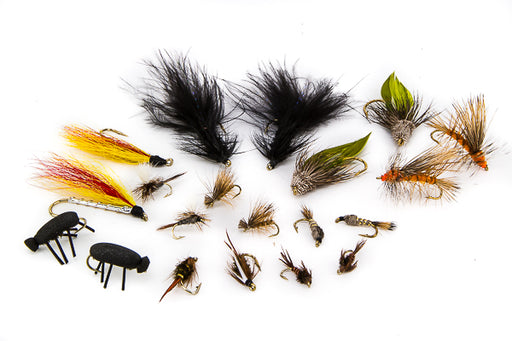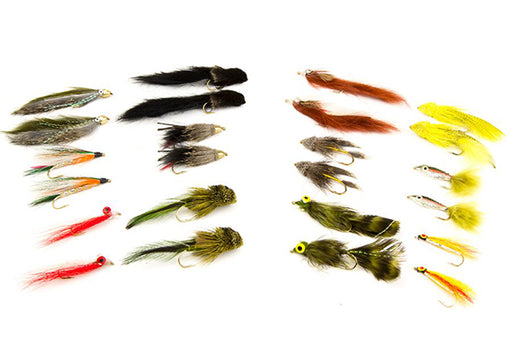
What Makes A Fly Rod
What Makes a Fly Rod?
-Things to consider when looking at fly rods.
Here are most of the things that you could consider when looking at fly rods. What makes a rod right for you and your situation, and what makes it cost what it does.
Fly rods work to deliver a fly line by creating a load on the rod. The load is created when the weight of the line stretches out and pulls on the rod, causing it to bend. The "action" of a fly rod is determined by where the rod flexes when it is loaded. This chart from Redington shows the flex of fly rods that have different actions.

Action of a Fly Rod
Fast action rods have a lot of backbone in them as they do not flex very far down the rod. Fast action rods are good at several things, including cutting through the wind with aggressive, long casts. they can handle large flies and the backbone in the rod allows for strong hook sets. These properties make them ideal rods for most saltwater scenarios, where casting long distances in the wind is more important than making a soft presentation to a picky trout at 30' away.

Slow action rods are just the opposite and have their benefits as well. Bamboo and fiberglass fly rods are slow action, and that is the only option that anglers had for many generations. Slow action rods have what is called "parabolic" actions. That means that there is an increase in flex at a constant rate from the butt to the tip. In real terms, it means that the rod will flex into the butt section when you hook a decently-sized fish. Slower rods excel at delivering subtle casts to spooky fish with light tippet. Slow rods tend to be very accurate (when loaded with the right line) and can put a very small fly into a very small area.
Rods that are labeled as medium action are usually actually more of a slow action. Slow is not a word that helps most rods sell, so slower rods tend to say medium on them no matter if they are slow or not. If they are a true middle of the road. they are likely labeled as medium/fast.
Medium/fast rods are that mama-bear rod. Not too slow, not too fast. They tend to be more forgiving when casting, which is great for beginners and weekenders. The butt sections of med/fast rods are still plenty strong for good hook sets and somewhat windy conditions. Most med/fast rods can handle a wide range of fishing scenarios, which is why most rods on the market are in the medium/fast category.
Overloading a rod. You can make a rod flex more by using a heavier line. The problem is that when you unload it, the rod can feel sluggish, become inaccurate, and the added stress may lead to breakage. Rods are designed to load and unload a certain amount of weight in a fly line.
Materials of a Fly Rod
Graphite: Most fly rods today are made with graphite. The graphite comes in a thin sheet and is rolled to specifications that are per-determined by the designers. There are different types of graphite that have different properties. Some graphite is lighter, some is faster, some is stronger, etc... But equally important are the other materials in that rod. There is a "scrim" as well as resins that hold the graphite in place and provide strength. the scrim and resin materials can have more effect on the feel and performance than the actual graphite.

Most fly rods are quite strong. They can lift up 10 pounds or more of dead weight tied to the tip. That is called lifting power. Manufacturers test their rods on a break board. It is quite impressive to watch a rod break at a factory. You can go to youtube and look at "fly rod break test" to see just how strong a rod is. That strength is great, but it is also uni-directional. It can pick up a lot of weight, but the hoop strength (around the circumference of the rod) is weaker than the lifting power, and rods are easy to crush. A fly rod is a lot like this:
Take two empty soda cans and stand them up on the ground. Most of us can carefully stand on two empty soda cans together and not cause them to crush. However, if you turn those cans on their sides and try to stand on them, they will crush very easily. A fly rod is a lot like that, the cans are strong in one direction, but crush easily from another. Fly rod manufacturers spend a lot of their research and development budget on figuring out how to improve that hoop strength.
Among other things that the R&D department has been working on with graphite rods is to reduce side-to-side wobble. When you load, and then unload a fly rod, it inevitably wobbles slightly from side to side as it unloads and returns to a "resting" position. Reduction of wobble is a hot topic among fly rod engineers. If you can put all of the energy into one load and one unload point, then you should be able to maximize the energy and focus it on increasing distance.
Fiberglass: Fiberglass rods were popular in the 1960's into the 1980s, and are making a comeback, although the fad seems to be waning. They have great feel, and are usually slow action. They are stronger, both in hoop strength and lifting power, but also weigh significantly more that graphite. There is far more material required to make fiberglass fly rods, and the process, from what I have been told, is more labor-intensive as the scrim doesn't easily mesh with the glass to create a smooth finish very easily. Redington's Butter Stick II is a nice little fiberglass rod that performs well and looks good.

Blends: There are a couple of rods that have a fiberglass/graphite blend. The TFO Finesse Glass is one. The glass adds a lot of feel to the rod, while the graphite reduces weight from a purely glass rod while still having a nice, soft presentation. While fiberglass scrim is commonly used, making a blended rod is not a common manufacturing technique, but it is something that companies have done from time to time.
Bamboo: Fly rods were made from long strips of Tonkin Bamboo for many, many years. Today's bamboo rods are mostly showpieces and retirement gifts, as they are very expensive and are often very elaborately finished with extreme detail. The actions are usually slow or very slow, but bamboo provides incredible feel and touch for delivering flies.
Taper: The taper of a fly rod is basically the reduction of diameter from the butt section to the tip, as well as the amount of materials placed along an area of the rod. How and where that reduction happens, as well as the amount of materials used along the way results in the taper of the rod.
So how is the action of a fly rod determined? The action is a combination of the materials plus the taper. This is found through lots of math, as well as plenty of research & development, prototypes and afternoons casting on the lawn.

Components: Components are a critical part of a fly rod. Most anglers don't know that the thickness of the cork can affect the action of the rod. The types of guides on the rod, as well as their placement can have a huge impact on the action, as well as the likelihood of breaking.
Reel Seats: It may not seem important, but some reel seats lock the reel up into the cork area (uplocking) and others lock away from the grip (downlocking). That simple thing can change the proper weight for a reel to balance the rod, or it can make the rod more or less comfortable in hand. Most reel seats are uplocking, and I think that most anglers prefer them. However, anglers learning to spey cast might benefit more from a downlocking seat as it forces the angler's bottom hand to stay lower down, which is a benefit when learning to cast a two-hander.
Lock Rings: Another simple part of the reel seat that can make a difference is whether it has one or two locking rings. Reel seats with two rings tend to stay snug when fishing, while single locking seats have been known to loosen up and cause reels to fall off the rod. The 1/4 oz that the ring weighs (or the $2 that the company saved) may not be worth saving when you might dent your favorite reel.
Guides: The guides on the rod make an impact. There are stripping guides, which are the last one or two at the bottom of the rod. They usually have a ceramic ring in them and look like a guide for a spinning rod. Stripping guides help funnel the line to the other guides when casting. They are also heavy and expensive, so rods that are looking to save weight and money may have stripping guides that are either poor quality, too small or not enough of them.

There are two types of guides for the rest of the rod. Snake guides and single-foot guides. Snake guides look like an 'S' and connect to the rod on the top and the bottom of the guide. These are the most popular style. They are stronger than single-foot guides, but the extra thread that is required to make two attachments to the rod is enough weight that some manufacturers prefer the single-foot style. Yes, the weight of a little thread is considered by manufacturers when building a rod.

Single foot guides do help reduce the overall rod weight, but there are a couple of drawbacks. They are loud when used with polyethylene fly lines (as opposed to PVC), and they are more likely to bend as there is little to cause resistance when pushing forward on them.
The placement of the guides is also very important, as the manufacturer of the rod has determined exactly where pressure should be put on the rod. We must put our faith in quality manufacturing that the rod builders followed the guidelines that they determined.
Guides can be stainless steel or aluminum. Aluminum weighs quite a bit less, but will oxidize when exposed over time to saltwater. Many "saltwater" rods will sacrifice the weight of aluminum for the durability of steel. There are also stainless steel reel seats for those saltwater rods to make them more durable as well.
Cork: Cork is one of those things in fly rods that is maddening. Fly rod manufacturers admittedly have a hard time finding high-quality cork consistently and at decent prices. So the options are: 1) Using poor quality cork with lots of filler, or 2) Paying way too much for good cork, or 3) Using a component cork. Component cork is typically "rubberized", which means that little bits of cork are mixed with some type of rubber or silicone and then made into a handle. Most of today's cork is full of filler. You might not notice it until the handle has been worn down a bit from years of fishing. The filler doesn't darken up or wear down as much. It sticks out like a sore thumb on a well-worn fly rod. Composite cork is the way of the future, but we haven't all accepted that yet.

Weight of a Fly Rod: While improvements in technology, materials and techniques have drastically reduced the weight of fly rods, there are some things to consider when looking at that weight. A reduction in weight can reduce the "feel" of a rod. It is a lot harder to transfer the energy of the load down the rod to the cork (where your hand is) when there is less material to carry that energy. There are some really expensive, very lightweight rods out there that feel dead when you cast them.
Another thing to consider is what is called swing weight. This is essentially how the weight is distributed. How heavy does the tip feel when you are "swinging" the rod back and forth? It may not actually be heavy, but if it feels heavier than the back end of the rod, it will feel unbalanced and be uncomfortable to cast. Manufacturers have to build that into the rod, even if that means adding weight to the bottom end of the rod to balance out the top.

Single hand vs. Euro vs. Two-Handed Rods
There is definitely a difference between an 11' Euro nymphing rod and an 11' Switch (two-handed) rod. Just as there is definitely a difference between a 10' Euro nymphing rod and a 10' single hand rod.
Euro rods tend to have a slower action in the top half of the rod (more like top 2-3'), with a very drastic transition to a stiff bottom half. This helps anglers feel soft takes and the stiff butt helps anglers set the hook on those soft takes.
Spey/Switch rods tend to have a more uniform taper, where there is some flex in the top half, but the transition to the stiff butt section is spread out more than with a Euro rod that goes from soft to stiff really quickly. A fast action spey rod is still typically slower than most fast action single-hand rods, but they will have similar taper designs, even if they are 3'+ longer.
Why are most single handed rods 9'? Accuracy tends to increase as rods get shorter. The overall distance capabilities of a fly rod increase as the rod gets longer. So what happens when a rod goes over 9'? The swing weight of a rod increases to the point where it gets more tiresome to cast as it gets longer. That is why two-handed rods require two hands. The swing weight is more than a single hand can easily manage (without being worn out). 9' seems to be that sweet spot where a rod can get good distance, good accuracy and is not too heavy to fish all day.

Why does a rod cost $1000 and another one costs $100?
As we have discussed, there are a ton of things that go into building a rod. From top-end graphites, resins and components to a whole bunch of research & development, there are a ton of factors that go into determining how much the consumer should, can and will pay for a rod. Knowing what you want in a rod, as well as what your money will get you will ultimately help you make an informed decision about your next fly rod purchase.

Andrew Perrault
-Fishing, usually not catching









